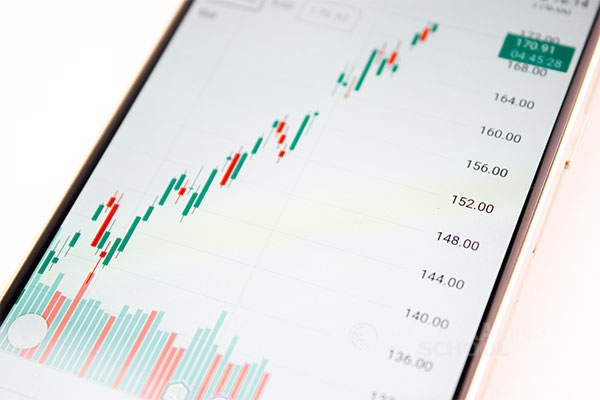Free Stock Trading Course
Lesson Four
Technical Analysis for Stock Trading
The fourth lesson in our free stock trading course covers the basics of technical analysis for stock trading which includes what is technical analysis, basic charting concepts, price, volume, and time, types of charts, line chart, bar chart, candlestick chart, chart patterns, trendlines, support and resistance, technical indicators, moving averages, MACD, RSI, Bollinger Bands, and using technical analysis to make stock trading decisions.

What is Technical Analysis?
Technical analysis for stock trading is a method of evaluating securities based on statistical analysis of market activity, including price and volume movements. Technical analysts believe that historical price and volume data can be used to predict future market trends and make informed investment decisions.
Technical analysis for stock trading involves the use of charts, indicators, and other tools to identify patterns in market activity. These patterns are used to make predictions about future market movements and to identify potential buying and selling opportunities.
One of the most commonly used tools in technical analysis for stock trading is the chart. Charts are used to display historical price and volume data for a particular security or market index. By analyzing patterns in the chart, technical analysts can identify trends, support and resistance levels, and other key indicators that can be used to make investment decisions.
Another key tool in technical analysis for stock trading is the indicator. Indicators are mathematical calculations that are based on market activity, such as price and volume movements. These indicators can be used to identify trends, momentum, and other key market factors that can be used to make investment decisions.
Technical analysis for stock trading also involves the use of various chart patterns, such as head and shoulders, triangles, and double bottoms. These patterns are used to identify potential reversal points or other key market signals that can be used to make investment decisions.
While technical analysis for stock trading is often used in conjunction with fundamental analysis, it is important to note that these two methods of analysis are fundamentally different. While fundamental analysis focuses on the underlying financial performance and intrinsic value of a company, technical analysis focuses on market trends and patterns.
Technical analysis for stock trading is a method of evaluating securities based on statistical analysis of market activity. By using charts, indicators, and other tools to identify patterns in market activity, technical analysts can make informed investment decisions and identify potential buying and selling opportunities. While technical analysis is not without its limitations, it remains a widely used and important tool for traders and investors looking to succeed in the stock market.
Basic Charting Concepts for Stock Trading
Technical analysis for stock trading involves the use of charts to identify patterns in market activity. Charts are an essential tool for traders and investors who want to analyze historical price and volume data to make informed investment decisions.
The three basic charting concepts used in technical analysis for stock trading are price, volume, and time. These concepts are used to identify trends, support and resistance levels, and other key indicators that can be used to make investment decisions.
Price is one of the most important charting concepts in technical analysis for stock trading. Price charts display the historical price movements of a particular security or market index. By analyzing patterns in the price chart, technical analysts can identify trends, support and resistance levels, and other key market indicators.
Volume is another important charting concept in technical analysis for stock trading. Volume charts display the historical volume of trading activity for a particular security or market index. High trading volumes can indicate strong buying or selling pressure, while low trading volumes can indicate weak market activity.
Time is also an important charting concept in technical analysis for stock trading. Time charts display the historical price and volume data over a specific time period. By analyzing patterns in the time chart, technical analysts can identify trends, support and resistance levels, and other key market indicators.
Technical analysis for stock trading also involves the use of various chart types, such as line charts, bar charts, and candlestick charts. These charts display price and volume data in different ways and can be used to identify different patterns and trends in market activity.
While technical analysis for stock trading is not without its limitations, it remains a widely used and important tool for traders and investors looking to succeed in the stock market. By using basic charting concepts such as price, volume, and time, technical analysts can identify potential buying and selling opportunities and make informed investment decisions.
Types of Charts for Stock Trading
Technical analysis for stock trading involves the use of various chart types to analyze historical price and volume data. There are several different types of charts that traders and investors use to make informed investment decisions.

One of the most basic chart types in technical analysis for stock trading is the line chart. Line charts display the historical price data of a particular security or market index over time. This chart type is simple and easy to read, making it a popular choice for beginners in the stock market.
Another common chart type used in technical analysis for stock trading is the bar chart. Bar charts display the historical price and volume data of a particular security or market index over time. This chart type is more detailed than a line chart, making it useful for identifying patterns and trends in market activity.
Candlestick charts are another popular chart type used in technical analysis for stock trading. Candlestick charts display the historical price and volume data of a particular security or market index over time, using candlestick shapes to represent different market patterns. This chart type is highly detailed and can provide traders and investors with a lot of information about market activity.
Technical analysis for stock trading involves using different chart types to identify patterns and trends in market activity. By analyzing historical price and volume data, traders and investors can identify potential buying and selling opportunities and make informed investment decisions.
It’s important to note that each chart type has its own strengths and weaknesses, and traders and investors must choose the chart type that best suits their needs and investment goals. For example, line charts may be useful for beginners who are just getting started in the stock market, while candlestick charts may be more suitable for experienced traders and investors looking for highly detailed market information.
Stock traders can use technical analysis and charts to study stocks like Amazon, Apple and Google before investing in these companies.
Chart Patterns for Stock Trading
Technical analysis for stock trading involves using different chart patterns to identify potential buying and selling opportunities. Chart patterns are formed when the price of a security or market index moves in a specific way, indicating a potential change in market direction. Here are some of the most common chart patterns used in technical analysis for stock trading.
Trendlines are one of the simplest and most widely used chart patterns in technical analysis for stock trading. Trendlines are diagonal lines that connect two or more price points and can be used to identify the direction of the market trend.
Support and resistance levels are another important chart pattern in technical analysis for stock trading. Support levels are price points at which buyers are likely to enter the market, while resistance levels are price points at which sellers are likely to enter the market.
Continuation patterns are chart patterns that indicate a pause in the current market trend before it continues in the same direction. Examples of continuation patterns include the flag and the pennant.
Double bottom and double top patterns are chart patterns that indicate a potential reversal in the market trend. A double bottom pattern is formed when the price of a security or market index hits a low point twice, while a double top pattern is formed when the price hits a high point twice.
Head and shoulders patterns are chart patterns that indicate a potential reversal in the market trend. A head and shoulders pattern is formed when the price of a security or market index hits a high point, followed by two lower high points.
Reverse head and shoulders patterns are the opposite of head and shoulders patterns and indicate a potential reversal in the market trend. A reverse head and shoulders pattern is formed when the price of a security or market index hits a low point, followed by two higher low points.
By using these chart patterns, traders and investors can identify potential buying and selling opportunities in the stock market. Technical analysis for stock trading involves studying these patterns and using them to make informed investment decisions.
It’s important to note that chart patterns should be used in conjunction with other technical analysis tools, such as indicators and oscillators, to confirm potential market trends. Technical analysis for stock trading requires a combination of chart patterns, indicators, and other tools to make informed investment decisions.
Candlestick Patterns for Stock Trading
Technical analysis for stock trading involves using different chart patterns to identify potential buying and selling opportunities. Candlestick patterns are a popular type of chart pattern in technical analysis for stock trading. Candlestick charts display price movements using candlestick shapes, each representing a specific time frame. The patterns formed by these candlesticks can provide traders and investors with valuable information about potential market trends. Here are some of the most common candlestick patterns used in technical analysis for stock trading.

The first candlestick pattern is the doji, which represents indecision in the market. The doji is formed when the opening and closing prices are the same, and the wicks of the candlestick are longer than the body. Traders use the doji to identify potential trend reversals.
The second candlestick pattern is the hammer, which is a bullish reversal pattern. The hammer is formed when the price opens and then drops significantly during the day, but recovers and closes near the opening price. Traders use the hammer to identify potential buying opportunities.
The third candlestick pattern is the hanging man, which is a bearish reversal pattern. The hanging man is formed when the price opens and then rises significantly during the day, but drops and closes near the opening price. Traders use the hanging man to identify potential selling opportunities.
The fourth candlestick pattern is the engulfing pattern, which is a bullish or bearish reversal pattern. The bullish engulfing pattern is formed when a small bearish candlestick is followed by a larger bullish candlestick. The bearish engulfing pattern is formed when a small bullish candlestick is followed by a larger bearish candlestick. Traders use the engulfing pattern to identify potential trend reversals.
The fifth candlestick pattern is the spinning top, which represents indecision in the market. The spinning top is formed when the opening and closing prices are near each other, and the wicks of the candlestick are longer than the body. Traders use the spinning top to identify potential trend reversals.
The sixth candlestick pattern is the morning star, which is a bullish reversal pattern. The morning star is formed when a long bearish candlestick is followed by a short candlestick with a small body, and then a long bullish candlestick. Traders use the morning star to identify potential buying opportunities.
The seventh candlestick pattern is the evening star, which is a bearish reversal pattern. The evening star is formed when a long bullish candlestick is followed by a short candlestick with a small body, and then a long bearish candlestick. Traders use the evening star to identify potential selling opportunities.
By using these candlestick patterns, traders and investors can identify potential buying and selling opportunities in the stock market. Technical analysis for stock trading involves studying these patterns and using them to make informed investment decisions.
It’s important to note that candlestick patterns should be used in conjunction with other technical analysis tools, such as indicators and oscillators, to confirm potential market trends. Technical analysis for stock trading requires a combination of candlestick patterns, indicators, and other tools to make informed investment decisions.
Candlestick patterns are a popular type of chart pattern in technical analysis for stock trading. Candlestick patterns such as the doji, hammer, hanging man, engulfing pattern, spinning top, morning star, and evening star can provide traders and investors with valuable information about potential market trends. By studying these candlestick patterns and using them in conjunction with other technical analysis tools, traders and investors can make informed investment decisions and potentially achieve success in the stock market.
Technical Indicators for Stock Trading
Technical analysis is a method used by traders and investors to analyze stock prices and forecast future trends based on past market data. Technical indicators are an important component of technical analysis for stock trading, as they provide insights into the underlying trends and patterns of the stock market.
One of the most popular technical indicators for stock trading is moving averages. Moving averages are a mathematical calculation that smooths out price data over a specified period of time, allowing traders to identify trends and potential reversals. Traders often use moving averages to determine entry and exit points for their trades.
Another popular technical indicator is the Moving Average Convergence Divergence (MACD) indicator. The MACD is a trend-following momentum indicator that shows the relationship between two moving averages of a security’s price. The MACD is used to identify changes in trend, momentum, and potential buy or sell signals.
Relative Strength Index (RSI) is another widely used technical indicator for stock trading. It measures the strength of a stock’s price action by comparing upward movements to downward movements over a specified period of time. The RSI is typically used to identify overbought or oversold conditions in a stock, which can help traders make more informed decisions about when to enter or exit a trade.
Bollinger Bands is a popular technical indicator that is used to measure the volatility of a stock’s price over time. The indicator consists of three lines: a simple moving average (SMA) line in the middle, and two standard deviation bands above and below the SMA line. The bands expand and contract based on the volatility of the stock’s price, which can be used by traders to identify potential trend reversals or breakouts.
Stochastics is a momentum indicator that measures the closing price of a stock relative to its price range over a specified period of time. The indicator is typically used to identify overbought or oversold conditions in a stock, which can help traders make more informed decisions about when to enter or exit a trade.
Using Technical Analysis to Make Stock Tading Decisions
Technical analysis is an approach to stock trading that uses past market data to identify patterns and trends, and make predictions about future price movements. By analyzing price charts, traders can identify key support and resistance levels, as well as market trends and potential trading opportunities. Technical analysis for stock trading involves the use of various tools and techniques to help traders make more informed investment decisions.
One of the most important tools in technical analysis for stock trading is the use of technical indicators. These indicators are mathematical calculations based on historical market data, and they provide traders with valuable information about market trends, momentum, and potential buying or selling opportunities. Some of the most popular technical indicators used in stock trading include moving averages, MACD, RSI, Bollinger Bands, stochastics, and oscillators.
Moving averages are one of the simplest and most widely used technical indicators in stock trading. They help traders identify the average price of a stock over a specified period of time, and can be used to identify trends and potential buying or selling opportunities. The MACD (moving average convergence divergence) is another popular technical indicator that is used to identify changes in momentum and trend. It consists of two moving averages that are plotted on the price chart, and traders look for crossovers and divergences to identify potential trading opportunities.
The RSI (relative strength index) is another technical indicator that is commonly used in stock trading. It measures the strength of a stock’s price relative to its own past performance, and is often used to identify overbought or oversold conditions. Bollinger Bands are another popular technical indicator that is used to identify volatility and potential trading opportunities. They consist of a moving average and two standard deviation lines, and traders look for price movements that break above or below the standard deviation lines to identify potential buy or sell signals.
Stochastics is another technical indicator that is used to identify overbought and oversold conditions in the market. It measures the position of a stock’s closing price relative to its price range over a specified period of time, and can help traders identify potential turning points in the market. Finally, oscillators are a type of technical indicator that is used to identify changes in momentum and trend. They are calculated based on a stock’s price and volume data, and can provide traders with valuable information about market trends and potential trading opportunities.
Technical analysis for stock trading is a valuable tool that can help traders make more informed investment decisions. By using technical indicators, traders can identify trends, momentum, and potential buying or selling opportunities in the market. Some of the most popular technical indicators used in stock trading include moving averages, MACD, RSI, Bollinger Bands, stochastics, and oscillators. However, it is important to remember that technical analysis should not be used in isolation, and should be combined with other forms of analysis, such as fundamental analysis, to make more informed investment decisions.
Get FREE Early Access to
Exclusive Trading Content!
Find the Next BIG Investment Opportunity Before Everyone Else
This concludes the Technical Analysis for Stock Trading lesson. Please use the menu below to navigate to the lesson of your choice.
